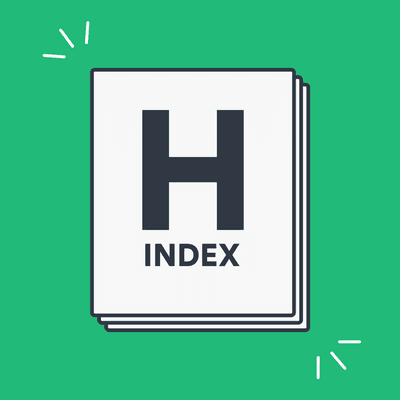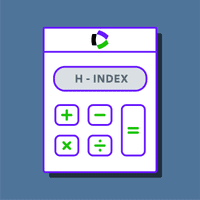What is a good h-index? [with examples]

What is an h-index?
An h-index is a rough summary measure of a researcher’s productivity and impact. Productivity is quantified by the number of papers, and impact by the number of citations the researchers' publications have received. It can be useful for identifying the centrality of certain researchers as researchers with a higher h-index will, in general, have produced more work that is considered important by their peers.
➡️ You can learn all about the h-index, why it is important, and how to calculate it, in this guide: The ultimate how-to-guide on the h-index
How to calculate your h-index
As Jorge E. Hirsch, the creator of the h-index describes it, the index h is “the number of papers with citation number ≥h.” While this formula might not explain much, it makes it clear any researcher is able to calculate their h-index. Below are some guides that will help you find or learn how to calculate your h-index:
➡️ Learn how to calculate your h-index on Google Scholar
➡️ Learn how to calculate your h-index using Scopus [3 steps]
➡️ Learn how to calculate your h-index using Web of Science
➡️ The ultimate how-to-guide on the h-index (to calculate it yourself)
Now let’s talk numbers: what h-index is considered good?
But let's go into more detail and have a look at what a good h-index means in terms of your field of research and stage of career.
What is a good h-index for a PhD student?
It is very common for supervisors to expect up to three publications from PhD students. Given the lengthy process of publication and the fact that once the papers are out, they also need to be cited, having an h-index of 1 or 2 at the end of your PhD is a big achievement.
What is a good h-index for a Postdoc?
Given that there is no defined time for how long postdoctoral training can go on, let's assume that an average Postdoc is able to publish one paper a year. Building on the papers already published during his/her PhD studies, there is a good chance that after two years of postdoctoral training, it is a total of 5 papers. If each of these 5 papers has been cited 5 times, that makes an h-index of 5.
What is a good h-index for an assistant professor?
Below you will find a sample of assistant professors and their h-index ratings:
| Name | University | Research area | h-index |
|---|---|---|---|
Yuan Lu | Yale | Cardiovascular epidemiology | 30 |
Mohammad Alizadeh | MIT | Computer networks | 44 |
Manuel A. Rivas | Stanford | Human genetics | 39 |
Mark L. Hatzenbuehler | Columbia | LGBT health disparities | 66 |
Martin J. Aryee | Harvard | Statistics | 49 |
What is a good h-index for an associate professor?
Below you will find a sample of associate professors and their h-index ratings:
| Name | h-index | University | Research area |
|---|---|---|---|
Richa Saxena | 63 | Harvard | Genetics |
Ivan P. Gorlov | 27 | Dartmouth | Bioinformatics |
Arvind Narayanan | 41 | Princeton | Information privacy |
Alon Keinan | 45 | Cornell | Computational genomics |
Yajaira Suarez | 44 | Yale | MicroRNAs |
What is a good h-index for a full professor?
Below you will find a sample of full professors and their h-index ratings:
| Name | h-index | University | Research area |
|---|---|---|---|
Fredo Durand | 88 | MIT | Computer graphics |
James E. Hansen | 100 | Columbia | Climate change |
Li-Jia Li | 35 | Stanford | Machine learning |
Olivia S. Mitchell | 78 | University of Pennsylvania | Economics |
Enrique Rodriguez Boulan | 84 | Cornell | Cell polarity |
These numbers shouldn’t be taken as the yardstick of comparison, as every researcher has different experiences, and the h-index is not the only measure that defines them. Hirsch states that “obviously a single number can never give more than a rough approximation to an individual’s multifaceted profile, and many other factors should be considered in combination in evaluating an individual.”
In conclusion, having a good h-index is great, but every researcher's case is multifaceted. There are plenty of other aspects to consider while evaluating a researcher.
Frequently Asked Questions about h-index
🐹 What is an h-index?
An h-index is a rough summary measure of a researcher’s productivity and impact. Productivity is quantified by the number of papers, and impact by the number of citations the researchers' publications have received.
🐭 How do I calculate my h-index on Google Scholar?
Google Scholar can automatically calculate your h-index, read our guide How to calculate your h-index on Google Scholar for further instructions.
🐨 How do I calculate my h-index on Scopus?
Even though Scopus needs to crunch millions of citations to find the h-index, the look-up is pretty fast. Read our guide How to calculate your h-index using Scopus for further instructions.
🐰 How do I calculate my h-index using Web of Science?
Web of Science is a database that has compiled millions of articles and citations. This data can be used to calculate all sorts of bibliographic metrics including an h-index. Read our guide How to use Web of Science to calculate your h-index for further instructions.
🐼 Who invented the h-index?
Jorge E. Hirsch created the h-index in 2005. Here is the paper published in PNAS in which he outlines the h-index in detail.


